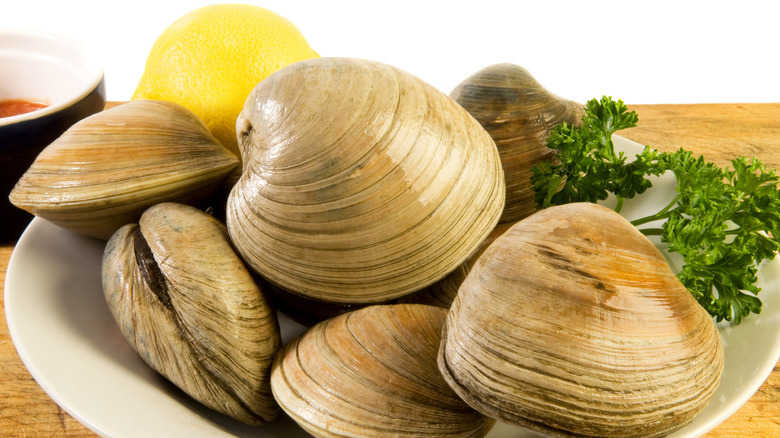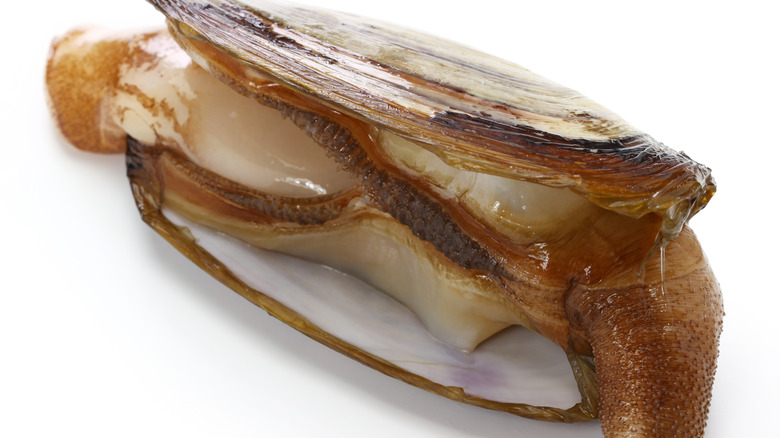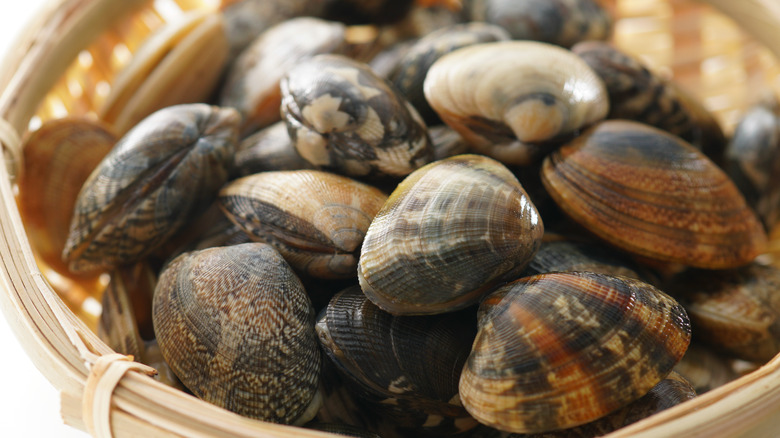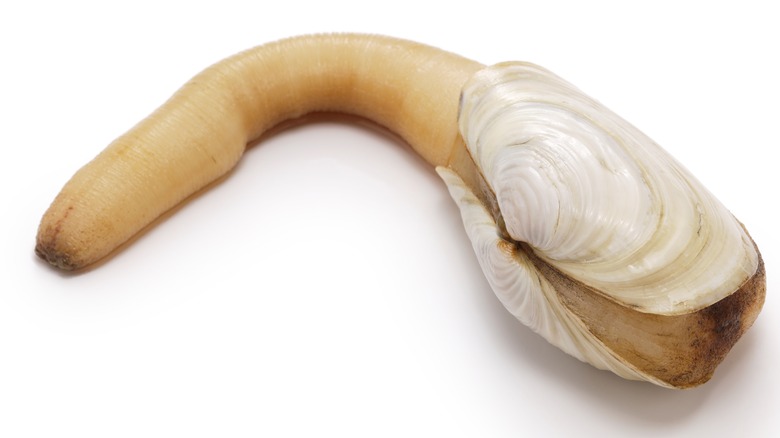10 Different Types Of Clams And How To Serve Them
If you grew up anywhere in the vicinity of an ocean, then there's a good chance you have fond memories of chowing down on these delicious mollusks. While folks from New England will remember clam bakes, a traditional summer meal prepared by steaming soft shell clams, quahogs, lobster, and mussels in an outdoor pit oven, those from the West Coast will likely reminisce fondly about digging into geoduck sashimi and stir fry.
These varying coastal traditions around eating different types of clams illustrate something essential about them — although these bivalves are all referred to as clams, they couldn't be more different. Not only are their habitats diverse, but so are their size, shape, flavor, and texture. Hundreds of species of clams exist, but in the U.S., there are around 10 different types of clams considered for culinary purposes. There is a lot that sets a hard-backed species apart from those with softer covers, but no matter how you look at it, there is more than one way to shell a clam.
Hard shell clams/quahogs
Quahogs take their name from poquauhock, the Narragansett word forthe mollusk. It is found on the East Coast of North America (from Nova Scotia to Florida, to be precise). Other common names include hard or hardshell clams. As a general rule, quahogs have tightly closed shells and come in a number of colors (white, cream, brown, and gray). They also have concentric growth rings, a feature used to determine their age.
The quahog group includes a number of varieties. From smallest to largest, these include countnecks, littlenecks, topnecks, cherrystones, and chowder clams. Countnecks usually have a diameter of about one inch, whereas chowder clams measure at least three inches in diameter when harvested. To be clear, all of these varieties belong to the quahog group. The only difference is the age at which they're harvested.
As you can probably guess, the younger, smaller clams are juicier and more tender than the older, larger types. For that reason, you'll see littlenecks served raw on the half shell alongside cocktail sauce and lemon. Chowder clams, on the other hand, are great stuffed or mixed into clam chowder. The flavor differs by size. Smaller clams taste mild and sweet, medium-sized clams are slightly briny, and larger varieties lean more savory.
Littleneck clams
Littleneck clams are the smallest variety of hard-shelled clams typically available for sale (countnecks can be sold legally, but they're uncommon). They're harvested when the shell's diameter measures about two inches. Like other quahog varieties, littlenecks are native to the East Coast. They're particularly abundant in the waters around Rhode Island and New York. In fact, this variety takes its name from Little Neck Bay on Long Island. Their shells are round and are marked with concentric rings. As for color, expect anything from white to brown.
Compared to older quahog varieties, littlenecks have juicy, tender meat. Their flavor is delicate and sweet. This, paired with their irresistible texture, makes them an easy choice for raw clams on the half shell. That said, they're also tasty when steamed and served with garlic butter and lemon sauce. Alternatively, you can steam them with aromatics, lager, potatoes, and sauce to create an irresistible Portuguese New England clam boil. Heck, they even work well when baked into clams casino, a dish that utilizes seafood and aromatics, bacon, white wine, Worchestire, and panko for an elegant bite. Is there anything these small clams can't do?
Cherrystone clams
Another hard-shelled variety to know is the cherrystone clam. Like its quahog siblings, you'll find cherrystones up and down the East Coast of the United States and Canada. Likewise, you can recognize them by their round shape, faint shell rings, and muted color. In terms of size, they're larger than littlenecks and smaller than chowder clams, measuring between around three inches when harvested.
In addition to their medium size, cherrystones are very middle-of-the-road clams when it comes to texture and flavor. They're not as tender or flavorful as littlenecks, but they're also not as chewy or savory as chowder clams. Smaller cherrystones can be served raw on the half shell, while larger ones should be reserved for steaming, broiling, and grilling. You're also likely to find cherrystones in New England clam chowder, clams casino, or pasta. If you're looking for some inspiration, allow us to recommend spaghetti with clams and green olives, a simple yet delicious meal you'll make again and again.
Soft shell clams/steamers
Soft shell clams are also native to the East Coast of the United States. More specifically, you will likely find this type in and around New England. Their shells are thin and oval-shaped, with colors ranging from cream to gray. In general, darker-colored shells have more flavor than lighter ones. These clams are also referred to as steamers, which hints at the ideal preparation technique.
After steaming, the clams are served with hot water (for cleaning) and clarified butter (for dipping). We recommend trying steamed clams and shallot butter for an even more refined preparation. This simple technique allows the tender texture to shine through. If you're looking for something even more indulgent, opt for the famous Ipswich, Massachusetts cooking method. This preparation style involves shucking, dredging, and frying the entire clam. Given the popularity of this method, you might see steamers referred to as Ipswich clams.
You might think three names is already too many, but these clams have one more title — longnecks. This moniker comes courtesy of the long siphons on soft shell clams. They're so long that most soft shell clams don't close all the way. On the one hand, this makes opening them easier. But on the other hand, it means you've got to spend time removing sand before serving. All that extra work is worth it, as both the siphon and the belly are subtly sweet and chewy.
Razor clams
Razor clams are native to the West Coast of the United States. You're most likely to find them in Oregon and Washington, but their habitat extends as far north as Alaska and as far south as California. Razor clams live longer in colder water, meaning they can grow up to a foot in length in Alaska. Farther south, expect them to grow to about six inches. Their shells are oblong and have a tannish-brown hue. They're also recognizable by the zipper-like closure around the edge of the shell. Be careful not to confuse Pacific razor clams for Atlantic razor clams. The Pacific variety is large and meaty, whereas the Atlantic variety is narrow and rectangular.
In terms of flavor, razor clams have a pretty mild taste compared to other clam varieties you might have tried. That said, they've got a sweet, slightly briny flavor that's unmistakable. When it comes to texture, expect a little bit of everything. The necks are meaty, the centers are chewy, and the tips are soft. We recommend using the siphon in either salads or ceviche. Tender tips make for excellent fried clams. To make them, dredge the clams in seasonings, then pan fry in oil. Other parts can be sautėed or mixed into pasta.
Atlantic jackknife clams
Also referred to as the Atlantic razor clam, this thin, elongated variety is native to the northern Atlantic Ocean from Canada to South Carolina. In recent years, the species has also been introduced to parts of Europe. Although they share the same name as Pacific razor clams, Atlantic razors have a thinner, more delicate shell that measures about six inches. The two types also differ in terms of flavor. Whereas Pacific razor clams taste briny, Atlantic razors have a sweeter, milder flavor and don't encompass as wide of a textural variety. Because they must be harvested by hand, they're also decidedly less common than their West Coast counterparts.
If you're lucky enough to get your hands on some Atlantic jackknife clams (and are willing to put effort into cleaning them), you'll have no trouble finding recipes highlighting this tasty variety. For example, you could try garlic butter razor clams. To make them, simply sautée clams in vegetable oil, then drizzle garlic butter sauce. Another option is to grill the clams. Serve with fish sauce, scallion oil, and crushed peanuts for a Vietnamese-inspired take on this unique clam variety.
Cockles
Unless you're a clam connoisseur, your only knowledge of cockles probably comes from the nursery rhyme "Mary, Mary, Quite Contrary." Rhymes aside, it turns out Mary was onto something with the cockles. For starters, these one-inch, heart-shaped mollusks are straight-up delicious. Unlike other types of shellfish that are overly saline, cockles are a sweetly meaty addition to lemon pasta. Cockles are also a great substitute for other types of clams or mussels (just make sure to triple the amount of cockles you add, given the small size). That means you can add them to garlic wine sauce and serve with potatoes or sprinkle them on top of your favorite pizza. Or, you can use cockles (canned or fresh) to make ceviche.
Whichever recipe you choose, make sure to cook cockles first. Unlike clams, they can't be eaten raw. Not only are cockles ridiculously delicious and versatile, but you'll have no trouble finding them. A lot of farmed cockles come from New Zealand, but you can find fresh ones from Massachusetts, the Pacific Northwest, and around the Gulf of Mexico.
Manila clams
Quahogs and steamers may dominate the East Coast clam scene, but the West Coast is (now) the domain of Manila clams. These mollusks have hard, oval-shaped shells imprinted with fine ridges that are splashed with wide bars of color. Although they can grow up to eight inches in diameter, most Manila clams are harvested at about three inches. They're native to Japan but were accidentally introduced to the West Coast of North America in the 1920s. Thankfully, this species has thrived in the ocean between British Columbia and Northern California.
Manila clams are prized for firm, juicy, oceanic meat. Essentially, they're everything you love about quahogs, minus the brininess. Given this attractive flavor profile, it makes sense that Manila clams are used in everything from pasta to soups. We're big fans of Chef Chad Colby's spaghetti with clams, a simple recipe combining olive oil, garlic, dry white wine, and fresh parsley. It's also tough to resist Katy Millard's Manila clams with couscous, cauliflower, and carrot sauce. Aside from these recipes, feel free to serve Manila clams raw on the half shell or steam them in a mixture of white wine, butter, and parsley.
Surf clams
Atlantic surf clam, bar clam, hen clam, skimmer, and sea clam — surf clams go by several different names. Despite its many monikers, surf clams don't get nearly the same amount of attention as other clams. That's pretty surprising, especially considering that surf clams make up most of the industrial clam products in the United States. This variety (native to the East Coast of North America from New England to South Carolina) is recognizable thanks to its hard, triangular shell and mild, sweet flavor. Other surf clam varieties include the Southern and Arctic surf clams.
Because they're large when harvested, measuring six inches in diameter and weighing up to two pounds, the meat of surf clams is tough and chewy. As a result, you're more likely to see them in soups and chowders rather than on a raw bar. Surf clams are also a popular type of canned clam, the juices of which can be used to amp up the flavor of seafood soups and pastas. This type is also fried into clam strips on occasion.
Geoduck clams
Pronounced gooey-duck, the geoduck clam looks as silly as it sounds. There are two varieties of this species: the Pacific geoduck, which is native to the Pacific Northwest, and the Atlantic geoduck, which is native to the Eastern seaboard, from North Carolina to the Gulf of Mexico. Both types have a white, oblong shell measuring six to nine inches long. What's more, mature geoducks can weigh up to seven pounds. That's wild as it is, but it's the geoduck's massive outer siphon that really draws attention. Depending on who you ask, a geoduck siphon looks like anything from an elephant trunk to a phallus.
The name geoduck comes from the Lushootseed language of the Nisqually Tribe. In their language, gʷídəq means "dig deep," a reference to the geoduck's profound habitat. Unlike other West Coast clams that burrow a few inches into the sand, geoducks are found two to three feet beneath the surface. It's certainly a lot of work to excavate them, but as with many clams, you'll be happy you did. Geoduck siphons are enjoyed raw in sashimi, sushi, and ceviche, whereas the belly is often tenderized and stir-fried or served in hot pots. Overall, the meat is briny, crunchy, and chewy, making it appropriate for all kinds of recipes.










